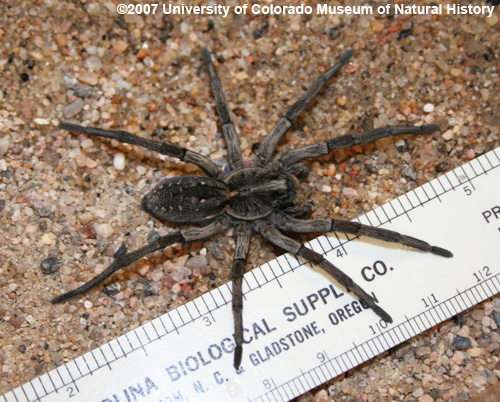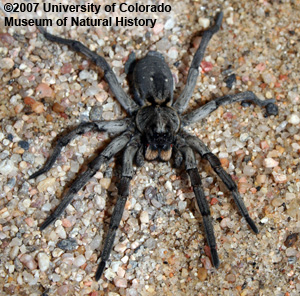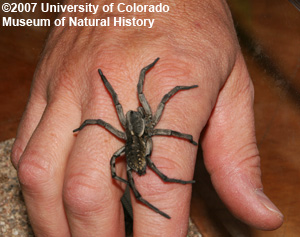OBJECT OF THE MONTH - OCTOBER 2007
Wolf Spider (Hogna carolinensis): 8-legged intrigue

Hogna carolinensis is Colorado's largest wolf spider with a body length of 1 inch and leg-span of almost 3 inches.
Hogna carolinensis is not only Colorado's largest wolf spider, it is also one of this state's most beautiful spiders. The males are particularly attractive, sporting a grayish coat accented with black and contrasting peach-colored chelicerae (mouthparts). The females of the species are mottled brown.

Hogna carolinensis males have a striking grayish coloration.
This species of wolf spider is found over much of the state and is especially common in Colorado's Front Range. This specimen was collected at a home in Boulder. It now lives in the Entomology Section at the University of Colorado Museum of Natural History and may be making special appearances at Museum functions in the future.
These solitary spiders are generally considered to be nocturnal, although they are sometimes seen roaming across fields during the day. Wolf spiders are active hunters that search out prey rather than ensnaring it in webs. They feed on insects or other ground dwelling arthropods and are very fast runners. This enables them to chase down prey as well as flee an area if they feel threatened.

Hogna carolinensis vs. man, showing size comparison. (Professional entomologist under lab conditions. We do not recommend or endorse the handling of wild spiders by the public.)
Each spider creates a short (approximately 4-inch) vertical silk-lined burrow, usually with a turret at the entrance. The spider uses this burrow as a protected retreat, emerging when in the mood for a snack. The female spiders not only carry their egg sac with them until the eggs hatch, but after hatching the mother spider carries her young for about a month before the spiderlings move off on their own. These spiders may live for several years.
We are very fortunate in Colorado to have an arachnologist interested in our local 8-legged fauna. Visit the Colorado Spider Survey at:
Colorado Spider Survey


